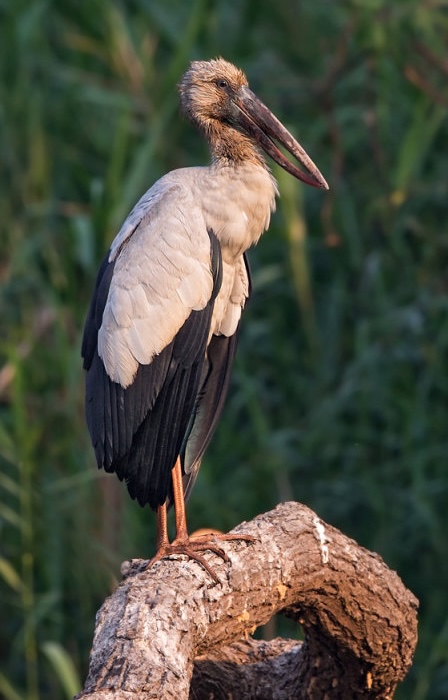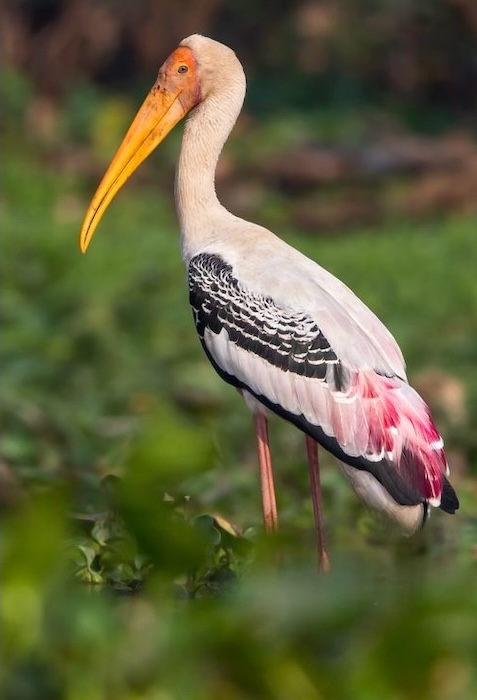Ciconiidae – Storks
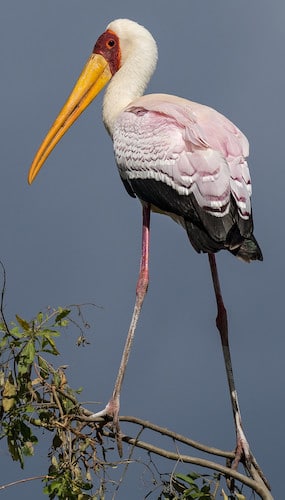
The Ciconiidae or Storks are large, long-legged, long-necked wading birds with long, stout bills. They are the only family in the order Ciconiiformes, which was once considered to be much larger and held a number of families.
Storks dwell in many regions and tend to live in drier habitats than the closely related herons, spoonbills and ibises; they also lack the powder down that those groups use to clean off fish slime. Storks have no syrinx and are mute, giving no call; bill-clattering is an important mode of communication at the nest. Many species are migratory. Most storks eat frogs and other amphibians, fish, insects, earthworms, small birds and small mammals. There are twenty living species of storks in six genera, currently recognised.
Various terms are used to refer to groups of storks, two frequently used ones being a muster of storks and a phalanx of storks.
|
|
|
|
Asian Openbill Anastomus oscitans |
Painted Stork Mycteria leucocephala |
|
All Photos in this text Dubi Shapiro |
|
Storks tend to use soaring, gliding flight, which conserves energy. Soaring requires thermal air currents. Storks are heavy, with wide wingspans: the Marabou Stork, with a wingspan of 3.2 metres and weight up to 8kg joins the Andean condor in having the widest wingspan of all living land birds.
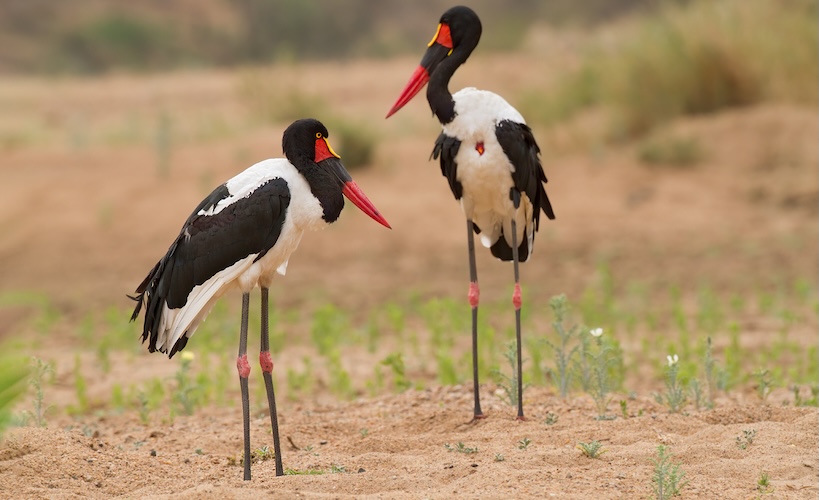
Saddle-billed Storks Ephippiorhynchus senegalensis
Their nests are often very large and may be used for many years. Some nests have been known to grow to over two metres in diameter and about three metres in depth. Storks were once thought to be monogamous, but this is only partially true. They may change mates after migrations, and may migrate without a mate.
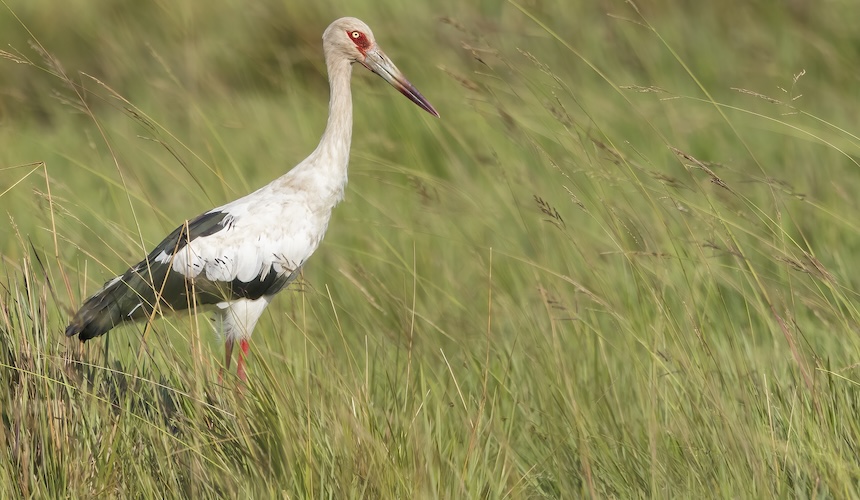
Maguari Stork Ciconia maguari
Storks’ size, assumed serial monogamy, and faithfulness to an established nesting site contribute to their prominence in mythology and culture.
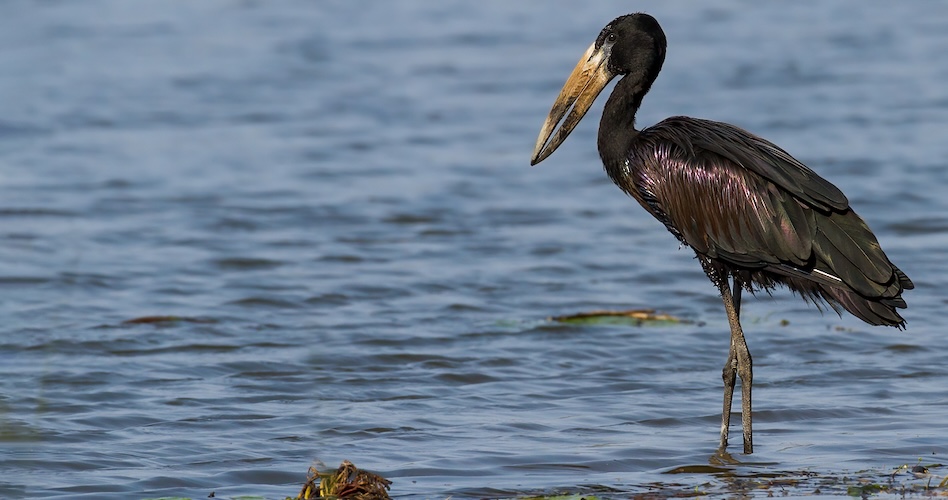
African Openbill Anastomus lamelligerus
The centres of stork diversity are in tropical Asia and sub-Saharan Africa, with eight and six breeding species respectively. Just three species are present in the New World: Wood Stork, Maguari Stork and Jabiru, which is the largest flying bird of the Americas. Two species, White Stork and Black Stork, reach Europe and western temperate Asia, while one species, Oriental Stork, reaches temperate areas of eastern Asia, and one species, Black-necked Stork, is found in Australasia (where it is confusingly often called jabiru).
-
Number of bird species: 20
(As at September 2025)
The recently (2025) amalgamated AviList recognises twenty species of storks in six genera the family Ciconidae. They are:
Asian Openbill Anastomus oscitans
African Openbill Anastomus lamelligerus
Marabou Stork Leptoptilos crumeniferus
Greater Adjutant Leptoptilos dubius
Lesser Adjutant Leptoptilos javanicus
Wood Stork Mycteria americana
Milky Stork Mycteria cinerea
Yellow-billed Stork Mycteria ibis
Painted Stork Mycteria leucocephala
Jabiru Jabiru mycteria
Saddle-billed Stork Ephippiorhynchus senegalensis
Black-necked Stork Ephippiorhynchus asiaticus
Black Stork Ciconia nigra
Maguari Stork Ciconia maguari
Oriental Stork Ciconia boyciana
White Stork Ciconia ciconia
Abdim’s Stork Ciconia abdimii
Storm’s Stork Ciconia stormi
African Woolly-necked Stork Ciconia microscelis
Asian Woolly-necked Stork Ciconia episcopus
-
Cranes, Herons & Storks of Australia
| By David Hollands | Green Book Co | 2017 | Hardback | 282 pages, 200+ colour photos, 1 colour map, colour distribution maps | ISBN: 9780992290016 Buy this book from NHBS.com -
Schwarzstorch (Black Stork)
| By G Burmeister & P Schroeder | VerlagsKG Wolf | 2004 | Hardback | 414 pages, Col figs, tabs | ISBN: 3894322195 Buy this book from NHBS.com -
The Painted Stork - Exploring Ecology and Conservation in India
| By Abdul Jamil Urfi | Pelagic | n2024 | Paperback | 191 pages, colour photos, colour illustrations, colour maps, colour tables | ISBN: 9781784274399 Buy this book from NHBS.com
-
Ciconiidae
Family AccountStorks are large, long-legged, long-necked wading birds with long, stout bills. They belong to the family Ciconiidae, and make up the order Ciconiiformes. -
Ciconiidae
Family AccountThe storks (Ciconiidae) and ibises (Threskiornithidae) are long-legged wading birds, who have many cultural associations...
Given that this is a medium sized family with twenty species in six genera, Fatbirder provides active links below to all species.
-
Abdim’s Stork Ciconia abdimii
Species AccountAbdim's stork (Ciconia abdimii), also known as the white-bellied stork, is a stork belonging to the family Ciconiidae. -
Abdim’s Stork Ciconia abdimii
Species AccountSound archive and distribution map. -
African Openbill Anastomus lamelligerus
Species AccountThe African openbill (Anastomus lamelligerus) is a species of stork from the family Ciconiidae. It is widely distributed in Sub-Saharan Africa and western -
African Openbill Anastomus lamelligerus
Species AccountSound archive and distribution map. -
African Woolly-necked Stork Ciconia microscelis
Species AccountA dark-brown stork with green-bronze iridescence on the wings and breast. It has a distinctive white ruffled neck, a white tail, and a dark salmon-tipped bill. -
African Woolly-necked Stork Ciconia microscelis
Species AccountSound archive and distribution map. -
Asian Openbill Anastomus oscitans
Species AccountA relatively small stork species with a grayish to white body and black wings and tail with a hint of gloss. -
Asian Openbill Anastomus oscitans
Species AccountSound archive and distribution map. -
Asian Woolly-necked Stork Ciconia episcopus
Species AccountA dark-brown stork with green-bronze iridescence on the wings and breast. It has a distinctive white ruffled neck, a white tail, and a dark salmon-tipped bill. -
Asian Woolly-necked Stork Ciconia episcopus
Species AccountSound archive and distribution map. -
Black Stork Ciconia nigra
Species AccountSound archive and distribution map. -
Black Stork Ciconia nigra
Species AccountThe black stork (Ciconia nigra) is a large bird in the stork family Ciconiidae. -
Black-necked Stork Ephippiorhynchus asiaticus
Species AccountLarge stately stork with an enormous black bill, black head and neck. Female has yellow eyes. In flight note white belly and mostly white wings. -
Black-necked Stork Ephippiorhynchus asiaticus
Species AccountSound archive and distribution map. -
Greater Adjutant Leptoptilos dubius
Species AccountImmense and imposing undertaker of a stork with a bare head and neck, pale eyes, and dark gray wings. -
Greater Adjutant Leptoptilos dubius
Species AccountSound archive and distribution map. -
Jabiru Jabiru mycteria
Species AccountJabiru mycteria is a large stork found in the Americas from Mexico to Argentina, except west of the Andes. It sometimes wanders into the United States. -
Jabiru Jabiru mycteria
Species AccountSound archive and distribution map. -
Lesser Adjutant Leptoptilos javanicus
Species AccountThe lesser adjutant (Leptoptilos javanicus) is a large wading bird in the stork family Ciconiidae. Like other members of its genus, it has a bare neck and head. -
Lesser Adjutant Leptoptilos javanicus
Species AccountSound archive and distribution map. -
Maguari Stork Ciconia maguari
Species AccountThe maguari stork (Ciconia maguari) is a large species of stork that inhabits seasonal wetlands over much of South America, and is very similar in appearance... -
Maguari Stork Ciconia maguari
Species AccountSound archive and distribution map. -
Marabou Stork Leptoptilos crumeniferus
Species AccountSound archive and distribution map. -
Marabou Stork Leptoptilos crumeniferus
Species AccountThe marabou stork (Leptoptilos crumenifer) is a large wading bird in the stork family Ciconiidae native to sub-Saharan Africa. -
Milky Stork Mycteria cinerea
Species AccountLarge white stork with a yellow bill and reddish face and legs. Extensive black on the wings and tail only prominent in flight; a little of this black... -
Milky Stork Mycteria cinerea
Species AccountThe milky stork (Mycteria cinerea) is a stork species inhabiting predominantly mangroves in Southeast Asia. It is native to Cambodia, Vietnam, Malaysia -
Milky Stork Mycteria cinerea
Species AccountSound archive and distribution map. -
Oriental Stork Ciconia boyciana
Species AccountThe Oriental stork is a large, white bird with black-feathered wings in the stork family Ciconiidae. -
Oriental Stork Ciconia boyciana
Species AccountSound archive and distribution map. -
Painted Stork Mycteria leucocephala
Species AccountThe painted stork (Mycteria leucocephala) is a large wader in the stork family. It is found in the wetlands of the plains of tropical Asia south of the Himalayas in the Indian Subcontinent and extending into Southeast Asia. Their distinctive pink tertial feathers of the adults give them their name. -
Painted Stork Mycteria leucocephala
Species AccountMycteria leucocephala is listed as Least Concern. -
Painted Stork Mycteria leucocephala
Species AccountSound archive and distribution map. -
Saddle-billed Stork Ephippiorhynchus senegalensis
Species AccountThe saddle-billed stork or saddlebill (Ephippiorhynchus senegalensis) is a large wading bird in the stork family, Ciconiidae. -
Saddle-billed Stork Ephippiorhynchus senegalensis
Species AccountSound archive and distribution map. -
Storm’s Stork Ciconia stormi
Species AccountStorm's stork (Ciconia stormi) is a medium-sized stork species that occurs primarily in lowland tropical forests of Malaysia, Indonesia and southern Thailand. -
Storm’s Stork Ciconia stormi
Species AccountSound archive and distribution map. -
White Stork Ciconia ciconia
Species AccountThe white stork (Ciconia ciconia) is a large bird in the stork family Ciconiidae. Its plumage is mainly white, with black on its wings. Adults have long red legs and long pointed red beaks. -
White Stork Ciconia ciconia
Species AccountCiconia ciconia is listed as Least Concern. -
White Stork Ciconia ciconia
Species AccountSound archive and distribution map. -
Wood Stork Mycteria americana
Species AccountThe wood stork (Mycteria americana) is a large American wading bird in the stork family Ciconiidae. It was formerly called the "wood ibis", though it is not an ibis. -
Wood Stork Mycteria americana
Species AccountA large, white, bald-headed wading bird of the southeastern swamps, the Wood Stork is the only stork breeding in the United States -
Wood Stork Mycteria americana
Species AccountSound archive and distribution map. -
Yellow-billed Stork Mycteria ibis
Species AccountBirdLife species account… -
Yellow-billed Stork Mycteria ibis
Species AccountSpecies account.... -
Yellow-billed Stork Mycteria ibis
Species AccountMycteria ibis is listed as Least Concern. -
Yellow-billed Stork Mycteria ibis
Species AccountSound archive and distribution map.
-
White Storks nest online camera POLAND
WebsiteWhite Storks nest online camera with up to 18x optical zoom - Przygodzice, Barycz Valley, South Wielkopolska region, Poland…

